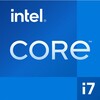Intel Core i7-1270P vs Apple M1 Max
Intel Core i7-1270P
► remove from comparison
The Intel Core i7-1270P is a higher-end Alder Lake-P family CPU, an expensive 28 W part meant for use in ultra-light, ultra-thin (yet actively cooled) laptops. This CPU was announced in early 2022 and it has 4 performance cores as opposed to the 6 cores of the top-of-the-line 1280P (P-cores, Golden Cove architecture) mated to 8 efficient cores (E-cores, Gracemont architecture). The P-cores are Hyper-Threading-enabled for a total of 16 threads when combined with the E-cores. The clock speeds range from 2.2 GHz to 4.8 GHz for the performance cluster and 1.6 GHz to 3.5 GHz for the efficient cluster. Full vPro feature set is supported by this Core i7 ("Enterprise" tier, allowing for remote device management). Its shortcomings as compared with the mighty i7-1280P include the smaller L3 cache, lower core count, lower clock speeds; the performance is slated to be significantly lower as a result.
A brief look at the specifications instantly reveals this i7 series chip to be very similar to the Core i5-12600H, a more power-hungry processor targeted at gaming laptops.
Architecture
The i7 is a continuation of Intel's efforts to use the ARM-developed big.LITTLE technology for its own benefit. A single "little" Alder Lake core is supposed to be as fast as a Skylake core (as found in the venerable Core i7-6700HQ among other options) which is six years old at this point. All of an Intel Core i7-1270P's CPU cores enjoy access to 18 MB of L3 cache. The integrated memory controller supports various memory types up to LPDDR5-5200, DDR5-4800, LPDDR4x-4267 or DDR4-3200. Intel suggests using no more than 64 GB, for reference. Just like the other 12th Gen Intel Core processors, Core i7-1270P comes with Thread Director which is a new functionality designed to help Windows 11 decide which cores to use for what workload for best performance and efficiency possible. Hardware acceleration of AI algorithms is supported via GNA 3.0 and DL Boost (via AVX2). PCI-Express 5.0 support has not found its way into Alder Lake P processors, so users will have to be content with PCI-Express 4.0 for the time being. Four PCI-Express 4 lanes allow for a read/write rate of up to 7.9 GB/s, provided a suitably fast NVMe SSD is used.
Please note this is not a user-replaceable CPU. It gets soldered permanently on to the motherboard (BGA1744 socket interface).
Performance
The 12 CPU cores are not just able to outshine any outgoing quad-core Tiger Lake part, the i7-1195G7 included. The average 1270P in our database directly competes with the Ryzen 7 5825U, the Ryzen 7 7730U and the Ryzen 7 7735U, meaning this little Core i7 is fast enough to make most consumers happy as of mid 2023.
The fairly high processing power comes at a cost. A single Golden Cove core can consume more than 20 W when under heavy load. Your mileage may thus vary depending on how high the Power Limits are and how competent the cooling solution of your laptop is.
Graphics
The built-in graphics adapter in the form of the 96 EU Iris Xe running at up to 1.40 GHz has seen no change from what was built into the 11th Gen Tiger Lake-UP3 processors, like an i7-1165G7, which is hardly a downside as this iGPU is loaded with modern features such as AV1 video decoding capability and SUHD 4320p monitor support. Up to 4 monitors can be used simultaneously with this iGPU. We expect the gaming performance to be reasonably close to that of NVIDIA's MX350.
In other words, the Xe is good enough for most games at 1080p resolution / Medium settings, provided the Power Limits are high enough and the cooling solution is competent enough. Fast RAM is a prerequisite for decent performance as well (the Xe has to make do with no dedicated video memory).
Last but not the least, we discovered that the GPU utilization when playing YouTube UHD 2160p60 videos is higher than it was with Tiger Lake chips.
Power consumption
The i7's base power consumption (also known as the default TDP or Power Limit 1) is 28 W, with 64 W being its maximum Turbo power consumption (also known as the PL2). As for the "Minimum Assured" power consumption, Intel's guidelines mention 20 W. All in all, an active cooling solution is a must for such a chip.
The CPU is built with Intel's fourth-gen 10 nm process marketed as Intel 7 for decent, as of late 2022, energy efficiency. It's still a rather power-hungry CPU; a single P-core will happily consume more than 20 W when under heavy load. A couple of the higher-end 7 nm U-class AMD Ryzen 5000 chips are not nearly as power-hungry while delivering similar or higher performance levels.
Apple M1 Max
► remove from comparison
The Apple M1 Max is a System on a Chip (SoC) from Apple that is found in the late 2021 MacBook Pro 14 and 16-inch models. It offers all 10 cores available in the chip divided in eight performance cores (P-cores with 600 - 3220 MHz) and two power-efficiency cores (E-cores with 600 - 2064 MHz). There is no Turbo Boost for single cores or short burst periods. The cores are similar to the cores in the Apple M1.
The big cores (codename Firestorm) offer 192 KB instruction cache, 128 KB data cache, and 24 MB shared L2 cache (up from 12 MB in the M1). The four efficiency cores (codename Icestorm) are a lot smaller and offer only 128 KB instruction cache, 64 KB data cache, and 4 MB shared cache. CPU and GPU can both use the 48 MB SLC (System Level Cache). The efficiency cores (E cluster) clock with 600 - 2064 MHz, the performance cores (P cluster) with 600 - 3228 MHz.
The unified memory (32 or 64 GB LPDDR5-6400) next to the chip is connected by a 512 bit memory controller (200 GB/s bandwidth) and can be used by the GPU and CPU. This is the main difference to the M1 Pro and the CPU performance is quite similar.
The biggest difference to the M1 Pro is the bigger integrated GPU with 24 or 32 cores (up from 16).
Furthermore, the SoC integrates a fast 16 core neural engine, a secure enclave (e.g., for encryption), a unified memory architecture, Thunderbolt 4 controller, an ISP, and media de- and encoders (including two ProRes engines).
The M1 Pro is manufactured in 5 nm at TSMC and integrates 57 billion transistors. The peak power consumption of the chip was advertised around 30W for CPU intensive tasks.
| Model | Intel Core i7-1270P | Apple M1 Max | ||||||||||||||||||||||||||||||||||||||||
| Codename | Alder Lake-P | |||||||||||||||||||||||||||||||||||||||||
| Series | Intel Alder Lake-P | Apple M1 | ||||||||||||||||||||||||||||||||||||||||
| Series: M1 |
|
| ||||||||||||||||||||||||||||||||||||||||
| Clock | 1600 - 4800 MHz | 2060 - 3220 MHz | ||||||||||||||||||||||||||||||||||||||||
| L1 Cache | 1.1 MB | 2.9 MB | ||||||||||||||||||||||||||||||||||||||||
| L2 Cache | 10 MB | 28 MB | ||||||||||||||||||||||||||||||||||||||||
| L3 Cache | 18 MB | 48 MB | ||||||||||||||||||||||||||||||||||||||||
| Cores / Threads | 12 / 16 | 10 / 10 | ||||||||||||||||||||||||||||||||||||||||
| TDP | 28 Watt | |||||||||||||||||||||||||||||||||||||||||
| Technology | 10 nm | 5 nm | ||||||||||||||||||||||||||||||||||||||||
| max. Temp. | 100 °C | |||||||||||||||||||||||||||||||||||||||||
| Socket | BGA1744 | |||||||||||||||||||||||||||||||||||||||||
| Features | DDR4-3200/LPDDR4x-4266/DDR5-4800/LPDDR5-5200 RAM, PCIe 4, Thr. Director, DL Boost, GNA, Rem. Platf. Erase, MMX, SSE, SSE2, SSE3, SSSE3, SSE4.1, SSE4.2, AVX, AVX2, BMI2, ABM, FMA, ADX, SMEP, SMAP, EIST, TM1, TM2, HT, Turbo, SST, AES-NI, RDRAND, RDSEED, SHA | ARMv8 Instruction Set | ||||||||||||||||||||||||||||||||||||||||
| iGPU | Intel Iris Xe Graphics G7 96EUs ( - 1400 MHz) | Apple M1 Max 32-Core GPU | ||||||||||||||||||||||||||||||||||||||||
| Architecture | x86 | ARM | ||||||||||||||||||||||||||||||||||||||||
| Announced | ||||||||||||||||||||||||||||||||||||||||||
| Manufacturer | ark.intel.com | |||||||||||||||||||||||||||||||||||||||||
| Transistors | 57000 Million |
Benchmarks
Average Benchmarks Intel Core i7-1270P → 100% n=13
Average Benchmarks Apple M1 Max → 110% n=13
* Smaller numbers mean a higher performance
1 This benchmark is not used for the average calculation













